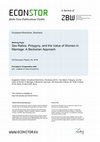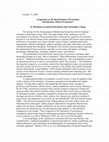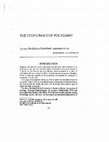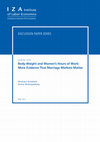Papers by Shoshana Grossbard

Social Science Research Network, 2014
A central component of his theory of marriage Becker's Demand and Supply (D&S) models of marriage... more A central component of his theory of marriage Becker's Demand and Supply (D&S) models of marriage are also among the most unique models he pioneered. Here I provide an overview of Becker's analysis of the effects of sex ratios-the ratio of men to women in marriage markets-on individual consumption of married men and women, and indicate some of the ways that this analysis has been expanded and tested. Becker also used D&S analysis to develop his argument that polygyny benefits women and used the positive association between brideprice and polygyny as evidence. Relying on D&S models of marriage and based on the section of Becker's Treatise on the Family dealing with "price" rigidities in marriage it is shown that polygyny may be harmful to women. Furthermore, the positive association between brideprice and polygyny does not necessarily prove that women are better off under polygyny than under monogamy.

Utah State University Press eBooks, 2016
A Demand and Supply analysis of marriage that assumes that marriage markets are free leads to the... more A Demand and Supply analysis of marriage that assumes that marriage markets are free leads to the conclusion that polygyny adds to women's value and enhances their well-being. However, wherever polygyny is found institutions are in place to curtail women's freedom and ability to obtain the very best partners in marriage: marriages are arranged for very young women, brideprice is often paid at marriage, employment for women is limited or prohibited, and women's sexual and emotional fulfillment is discouraged by ideological or physical means. Polygyny, an asymmetrical form of plural marriage, tends to serve the interests of the men likely to be polygynists at the expense of other groups. Having the power to institute and maintain polygyny these men also have the power to institute means of preventing women from capturing the gains that they would obtain had they been free to choose their marriage partners. There is no single example of a society that allows polygyny, an asymmetric form of polygamy, and simultaneously gives women the freedom to choose their marriage partners as commonly practiced in Western democracies. Worldwide, in the cultures and societies that have embraced it, polygyny is associated with undesirable economic, societal, physical, and emotional factors related to women's wellbeing. Many of the societies that have tolerated the practice of polygamy simultaneously recognize its harm in the form of institutions that limit the extent that polygyny can hurt women. Introduction. This article is based on a report prepared for the Supreme Court of British Columbia, Canada, when it was considering whether to eliminate Canada's anti-polygamy law (Grossbard 2010). It analyzes polygyny (many wives), not polyandry (many husbands) and relies on two assumptions often used since Becker's (1973) path-breaking economic analyses of marriage: (1) marriage is an institution that organizes household production, such production including giving birth, raising children, homemaking and many more activities, and (2) marriage markets exist. The economic analysis presented here starts with a Demand and Supply analysis of marriage pioneered by University of Chicago economist Gary Becker. From this analysis Becker (1973, 1981, 2006) concludes that polygyny adds to women's value based on a third assumption: marriage markets are free in the sense that the participants are free to choose and equilibrium prices are allowed to be established where markets clear. The results of a marriage market analysis depend strongly on whether all participants in marriage markets are free to maximize their own wellbeing. However, cultures allowing polygamy invariably also have laws and customs that prevent women from capturing the gains from marriage that could have accrued to them had they been free to choose their husbands. This paper lists and discusses some of these institutions. It then documents some of the harmful effects of polygyny for women and briefly discusses institutions aimed at alleviating this harm. From the perspective of political economy institutions are created and maintained due to the interests and influence of various groups in society. This also holds for marital institutions such as monogamy laws and bride price. The men who have an interest in establishing and
Journal of Economic Behavior and Organization, Dec 1, 1986
ABSTRACT "This paper derives and estimates an index of the relative importance of childr... more ABSTRACT "This paper derives and estimates an index of the relative importance of children in marriage by comparing the effect of husband's income on the actual number of wives in the household with the demand for wives derived from the number of children in the household. Moreover, the paper presents the monogamy bias as a possible explanation for often observed low or negative income effects on fertility." The data are from two surveys carried out around 1971 in Maiduguri, capital of the Northeastern state of Nigeria.
RePEc: Research Papers in Economics, Sep 1, 1998
RePEc: Research Papers in Economics, 1993
... On the economics of marriage: A theory of marriage, labor, and divorce. Post a Comment. CONTR... more ... On the economics of marriage: A theory of marriage, labor, and divorce. Post a Comment. CONTRIBUTORS: ... PAGES (INTRO/BODY): xviii, 349 p. SUBJECT(S): Marriage; Married women; Economic aspects; Employment; United States. DISCIPLINE: No discipline assigned. ...

Part I. On the History of Demography Q. You have been a prominent demographer and sociologist for... more Part I. On the History of Demography Q. You have been a prominent demographer and sociologist for many years. What do you consider yourself first, a demographer or a sociologist? A. I prefer to consider myself a demographer rather than a sociologist. That is because I and other demographers are interested in quantitative research, whereas many sociologists do only qualitative research. Q. What is demography? A. I would define demography as the study of populations, which would include the composition of existing populations and the study of the components of population change: natality, mortality, in-migration and out-migration. Q. From the start, demography has been a multidisciplinary field. Can you tell me more about the origin of demography as a science? A. There have been two principal founders of demography: John Graunt and Thomas Malthus. Graunt was a statistician in 17 th Century England. He invented the life table, a major tool in all demographic analysis. Malthus was an economist and an Anglican minister who became very concerned with the question of how population growth

We investigate whether in the U.S.A. hours of household work vary by whether individuals are in d... more We investigate whether in the U.S.A. hours of household work vary by whether individuals are in differentrace or same-race couples. Data from the American Time Use Survey data for years 2003-2009 are analyzed for samples of White and Black male and female respondents. We find that White women married to Black men devote 0.7 fewer hours per day to housework than their counterparts in all-White marriages, which is comparable to the effect of a young child on their hours of housework. Findings for White men also indicate that they work less at housework when in couple with Black women than when in all-White couples. Conversely, Blacks appear to do more housework if they are in couple with Whites than when in all-Black couples. Results are sensitive to whether time use was measured on weekdays or weekends, relationship status, and employment status in ways that are consistent with our theoretical framework based on Becker's second Demand and Supply model and the concept of Work-In-Household for the benefit of a partner or spouse.
Journal of Socio-economics, 2002
aspects of demography, including fertility, migration, and couple formation. He has
The Routledge Handbook of the History of Women’s Economic Thought, 2018
In the USA, husbands are on average two years older than their wives. When people born during a b... more In the USA, husbands are on average two years older than their wives. When people born during a baby boom are ready to get married, there are (...)

The Society for the Advancement of Behavioral Economics held its biannual meetings in San Diego i... more The Society for the Advancement of Behavioral Economics held its biannual meetings in San Diego in June 1999. The major theme of the conference was the reorientation of economics. Recent decades have witnessed an expansion of economics beyond its core theories based on the assumptions of rational self-interest and exogenous preferences. Economists now study a broader scope of topics, including motivation, organization, cultural assimilation, religion, marriage, and many other topics previously considered outside their discipline. Participants were invited to present papers exploring the relationship between economics and other social science disciplines, including psychology, anthropology, sociology, political science, and statistics. The proliferation of research at the intersection of economics with these other disciplines prompts us to ask, what is economics? What differentiates it from other social sciences? Traditional definitions are no longer satisfactory. One such definition...
This paper points to parallels between the economic approach to marriage and Jewish Law. The econ... more This paper points to parallels between the economic approach to marriage and Jewish Law. The economic approach is applied to the sex ratio question, the price of Torah scholars, the need for marriage brokers, marriage contracts and polygamy, all topics also addressed by Jewish law.

Polygamy can take the form of polyandry (several men share a woman) or of polygyny (a man marries... more Polygamy can take the form of polyandry (several men share a woman) or of polygyny (a man marries several women). The latter form is more common, as nearly all sub-Saharan and most Muslim countries permit it. In parts of sub-Saharan Africa, as many as 35% of married men are polygynous (Dorjahn, 1959), so that the majority of the population participates in a polygynous household at some time. This paper uses economic theory to offer insights into the determinants of polygamy. Since I will try to establish some correspondence between theory and facts around the world, the focus will be on the more common type of plural marriage, polygyny. The theory developed in the first section is based on Becker's economics of marriage. Although anthropologists (for instance, Goldschmidt, 1974) and sociologists (for instance, Rosenthal, 1970) have previously used the concept of marriage market, they have not developed the theoretical implications of

SSRN Electronic Journal, 2017
Any opinions expressed in this paper are those of the author(s) and not those of IZA. Research pu... more Any opinions expressed in this paper are those of the author(s) and not those of IZA. Research published in this series may include views on policy, but IZA takes no institutional policy positions. The IZA research network is committed to the IZA Guiding Principles of Research Integrity. The IZA Institute of Labor Economics is an independent economic research institute that conducts research in labor economics and offers evidence-based policy advice on labor market issues. Supported by the Deutsche Post Foundation, IZA runs the world's largest network of economists, whose research aims to provide answers to the global labor market challenges of our time. Our key objective is to build bridges between academic research, policymakers and society. IZA Discussion Papers often represent preliminary work and are circulated to encourage discussion. Citation of such a paper should account for its provisional character. A revised version may be available directly from the author.
The Marriage Motive: A Price Theory of Marriage, 2014

Review of Economics of the Household, 2021
The COVID-19 pandemic is an unprecedented event with wide-ranging implications. Given that househ... more The COVID-19 pandemic is an unprecedented event with wide-ranging implications. Given that households are at the center of major changes affecting the entire world, the Review of Economics of the Household is publishing a series of issues on COVID-19 and the economics of the household. Here we review eight articles documenting the enormous costs of the COVID containment policies, in particular the school closures that ensued. Individuals paid a heavy cost in terms of disruption in their attachment to the labor force. Children could not go to school and parents were forced to provide extra childcare and spend significant amounts of time helping children continue to learn, while possibly working from home. Domestic violence became more common. These changes have often been traumatic, to the detriment of the well-being and mental health of large numbers of people. Women have paid a higher price than men, as many of the studies demonstrate. Our conclusion calls for policy-makers to prepare for the post-traumatic period: many households will need help.
Journal of Economic Behavior & Organization, 1986
ABSTRACT "This paper derives and estimates an index of the relative importance of childr... more ABSTRACT "This paper derives and estimates an index of the relative importance of children in marriage by comparing the effect of husband's income on the actual number of wives in the household with the demand for wives derived from the number of children in the household. Moreover, the paper presents the monogamy bias as a possible explanation for often observed low or negative income effects on fertility." The data are from two surveys carried out around 1971 in Maiduguri, capital of the Northeastern state of Nigeria.
Uploads
Papers by Shoshana Grossbard